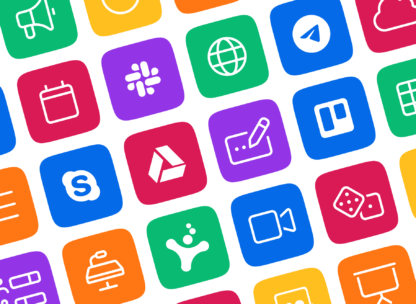12 leadership roles for effective, dynamic leaders

While leaders might appear to occupy a single position, the reality is that leaders often need to be fluid and shift leadership roles in order to effectively manage and empower their team.
Sometimes, leaders take the role of a coach and help team members find opportunities to grow. On other occasions, they need to be a decision maker on an important matter or sometimes hold space for the rest of the team in the role of a facilitator. Understanding these roles, when to deploy them and how they can impact your team can help you be a more engaging and effective team leader.
In this guide, we’ll explore the different leadership roles you can use to best support your team and achieve your goals. Great leaders are flexible, knowing that different situations and challenges require different approaches.
We’ll share the core mindset and use cases of 12 leadership roles and explore some of the ways you might use them in order to become a more thoughtful and effective leader.
How can understanding leadership roles make you a better leader?
As a new leader, I found myself wondering about my role in certain conversations and spaces. Sometimes, it’s appropriate to delegate work and get buy-in from your team while occupying the position of a traditional manager.
On other occasions, this role created a dynamic that stifled creativity and left team members looking to me for next steps when the goal was to encourage empowerment and autonomy. What was going wrong?
The truth is that different leadership situations call for a different skill set, strategy and approach. As a leader, you often need to shift your role based on the needs of your team.
Sometimes, you need to make key business decisions or simply provide training, while other times you need to facilitate a conversation where your team can arrive at their own learnings and solve problems in the way that works for them.
When I think of the bad leaders I’ve worked with (and there have been a few) I often wonder whether part of the problem was down to the rigidity of their leadership style and a lack of awareness of what their team needed at a given moment.
Effective leadership often means knowing when to step back and giving your team space to grow. It also means knowing when you have to be the decision maker and step-in to stop something from going wrong. It’s all about balance, flexibility and dynamically responding to what your team and organization needs.
Good leaders often use different leadership roles instinctively and can be dynamic when it comes to working with their team. Great leaders work to gain a better understanding of these roles and how to use them more effectively.

The different roles of a leader
While it takes skill, practice and self-reflection, understanding the different roles of a leader and how to move between them is a great place to begin.
The first step is awareness. Knowing what roles you might already by using, what others might be available to you and when you should deploy them can help you be a better leader.
It can be helpful to check-in with yourself throughout the day and ask which leadership role you are occupying and whether it is the most appropriate role for the situation you are in.
On various occasions, I’ve caught myself trying to be an organizer when I needed to step back and be a coach. I’ve tried to be a manager on a certain project when actually, I needed to step into the role of an individual contributor.
Not being mindful or simply applying the same approach to every situation likely means you aren’t doing your best work or leaving space for others to grow and step up their game.
These different leadership roles will help you first understand and then occupy these positions in a way that benefits you and your team. Let’s take a look at the various leadership roles you might need to use in the workplace!
Coach
One of the most critical leadership responsibilities of a great leader is being a coach to their team members. When coaching, a leader uses their knowledge and experience to help team members grow and develop. This often means asking the right questions during meetings, arranging learning opportunities and learning to recognize the strengths, weaknesses, and abilities of their employees.
A successful coach will use all of their skills to motivate others with a mix of emotional support and professional expertise, both in groups and individually.
You’ll often occupy this role during performance review cycles and one-to-one meetings — helping to mutually explore challenges and agree on a plan of action together. This often creates a greater sense of trust and autonomy while also encouraging people to take a more active role in their own development.
Being an effective coach takes practice. Heck, it’s a whole career in itself! One key aspect of using this role effectively is balance. Give all of the space to your team member without also providing feedback and guidance and they may go down the wrong path. Take all of the space yourself and set tasks without discussion and you’re not truly including your team member in their own development.
Facilitator
Leadership and facilitation go hand-in-hand. A facilitator role means making things easier for a group, removing obstacles and enabling a team to do their best work.
Arguably, all leaders should also have a working knowledge of facilitation and be able to use these skills in their day-to-day work. That said, there are times when it’s important to switch cleanly into the position of facilitator and hold space for your team in that way.
Whether it’s managing conflict or handling group dynamics to ensure everyone in a room is able to contribute, this role is important when trying to enable teams to find their own solutions and solve big problems themselves.
Facilitators know when to get out of the way and empower the group to take ownership of a challenge. They know how to design a group process and plan workshops that get results and how to bring all the right people together – learning how to hold the position of facilitator as a leader can be one of the most effective ways of improving your team’s performance.
It’s worth noting that not every situation will ask you to actually be the person facilitating a workshop or meeting (though you should learn to do this too!).
Depending on the task, you might actually be more suited to being a visionary or decision maker and as such, you may want to bring in an external facilitator to help.
In any case, developing your facilitation skills and learning how to be a facilitator is a great way to bring extra value to your team and get the most out of your collaborations.
Influencer
Though this word has come to mean something completely different in the age of social media, the role of an influencer is a vital component of leadership.
In addition to providing helpful advice to their employees, authentic leaders must also lead by example and seek to be a role model for the rest of the team. When a team leader has sufficient knowledge, reputation, and professional experience, they’re in a great position to influence their employees and the organization at large. Leaders in this role often inspire action, sequester the resources to make things happen and champion the work of a team in the wider world.
The influencer role also comes with a level of responsibility. It’s always worth acknowledging when your level of influence outweighs your knowledge and getting input from people with domain expertise.
An example of this going wrong is when everyone agrees with what the CEO says, even when they’re not making the best decision. Instead of just using their influence to push through their own ideas, a great influencer uses their other skills to ascertain the best course of action and only then uses their influence to make things happen.
Sometimes, the role of a leader means practicing what you preach. While this is often true for any of the roles on this list, the influencer goes further by explicitly leading the way in behaviour they want to see and by modelling an approach they would like others to follow.
This might mean being the first one of the group to go through a new feedback process or to jump into the front lines of a difficult project to show an example of how to move forward. Acknowledging that there are times when you need to literally lead the way is an important aspect of being a great leader.
The influencer leadership role frequently extends beyond the confines of the organization and out into the wider industry. Great industry leaders always affect the opinions and behaviours of others in their field. Thought leadership, interviews and conference appearances are just some of the outward facing tasks a leaders as influencer might undertake.
Individual contributor
Sometimes, a leader can be at their most effective by getting involved directly in the work and getting things done. As a leader, I’ve found it useful for both myself and my team to knowingly shift into this role when circumstances need it. Meeting tough deadlines, problem solving or jumping in to help if your skillset is appropriate to the task at hand are some of the way a leader can contribute to the group achieving its goals.
The key is knowing when it is appropriate to occupy this role. Trying to manage and be an individual contributor all the time isn’t sustainable. You can be prone to burnout or letting things drop because you’re trying to juggle too many things. It can also create problems when it comes to enabling growth in your team and enabling self sufficiency.
If you’re always jumping in to help, this can become an expectation, and your team members may miss out on opportunities to practice and improve. As a leader, it’s your job to guide employees and help them grow, not just do the work for them!
In my experience, there is insight to be gained from being both inside and outside a problem or task. Good leaders know when it’s the right time to jump in and also when it’s better to step back.
So long as you use this role mindfully and not because you have a lack of trust in your team, you can achieve extraordinary results and also build relationships with your colleagues.
Trainer
While the leadership role of a coach sees managers recognising their employees’ individual strengths and weaknesses and utilising them correctly, the leadership responsibilities that stem from their role as a trainer are more practically growth-driven.
A trainer facilitates the professional improvement of their employees by organizing opportunities for them to tangibly improve their knowledge, abilities, and skills. They will lead seminars, source external training, participate in workshops, and find other methods of enhancing an employee’s (and their own) specific capabilities or skill sets.
Whether it’s imparting their own knowledge to others on the team or finding the right opportunities for learning, a trainer is adept at identifying knowledge gaps and plugging them efficiently.
Often, the lines between a trainer and facilitator blur. A useful delineation is to think of the trainer as someone who teaches and helps participants learn something specific. A facilitator often creates space for others to think and explore and create their own solutions with a guided process.
Teaching employees how to use Google Analytics with a powerpoint and specific exercises? That’s training. Leading an experiential workshop to help build leadership skills in team members who exhibit leadership potential? That’s facilitation. Both are valid: it’s just a matter of understanding when it’s better to occupy the role of a trainer or a facilitator.

Manager
Don’t confuse this leadership role with the job title of manager. Team management is just one skillset in a wider spectrum of roles that leaders will need to hold.
I often find it incredibly helpful to understand that while I am a manager, there are times when this role is in the driving seat, and times when a different approach is necessary.
As leaders of a group, managers must simultaneously guide and motivate others to achieve team goals while also organizing these efforts and facilitating them in practice.
This leadership role is about people management and task management. I think of the manager as the logistical and organzation head that ensures that everything a team needs to do gets done while also ensuring the group is held together.
In this role, a leader will oversee the work a team is doing, delegate tasks accordingly and ensure they stay on track. They enable their team with proper documentation, they think about how a team works together and spend time thinking about how to improve processes and overall team cohesion.
Onboarding new team members, managing group dynamics and running performance reviews and meetings are also key elements of a management role.
Managers pay attention to how the group is working together more generally and spot any challenges they may be facing. Managers often find opportunities to provide feedback using feedback techniques, and also step back and see chances to help individuals improve.
The manager is also responsible for representing the interests of their team at a company level. This might mean advocating for resources, synthesizing team feedback or simply bringing the collective knowledge of the team to the organization at large.
It’s a vital role that no leader can be without, but one mistake I’ve seen is when leaders only occupy the manager role and forget about the other needs of their team. A balanced leader is one who knows when this role is appropriate, doing it well, but then shifting as necessary.
Motivator
While most leadership roles contain an element of motivation, it’s worthy to note that there are times when what your team needs most is a cheerleader and a motivator.
In practice, this looks like firing up your group, getting them aligned and engaged, and also showing appreciation for their hard work. Sometimes, all we need to achieve greatness in our professional lives is someone in our corner. Being a motivator is all about rooting for your team, celebrating their work and mobilizing them for action.
Helping your team succeed as a motivator can also mean getting out of their way and simply enabling and giving appreciation for what your team is achieving. Leaders who are good motivators also know the value of soft approaches that build up over time, rather than single, big gestures. Often this looks like regularly giving positive feedback, celebrating your team when completing tasks and creating space to ask them what support they need.
A motivator also comes into their own when things aren’t going great or progress on a task has stalled. They may use the opportunity of a team meeting to remind the team of the why behind what they’re doing and how achieving those goals will contribute to the long term success of the organization.
Organizer
Being an effective organizer is crucial to being an effective leader. From being able to delegate responsibilities, to organizing strategies and complex group processes, strong organization skills are necessary, whatever size time you are leading.
I like to think of the organizer as a supporting role, and even when operating as a manager or facilitator, the organizer hat is helpful to put on. Creating dedicated time and space to think logically about admin, logistics and staying on top of everything is a simple but powerful way to utilize this role.
Shifting from a “doing things” to “thinking about doing things” mindset might seem like a small distinction, but it can help ensure things don’t fall through the cracks and that everything gets done in the most effective way.
Integrator/Strategist
Whatever the size of your organizations, there’s always a need for someone who can see the big picture and make strategic decisions that affect the whole company. Though the role here is heavily informed by the EOS framework, the integrator/strategist is a key leadership role that you may need to call on regardless of how your organization is structured.
As a strategist, it might fall to you to help design and implement new processes or make changes that affect the whole team. This is a role that often means thinking about how to create organizational growth and change and then helping teams practically adopt new systems.
It might also mean checking proposed actions against a company’s core values and seeking to understand how decisions might affect employees or customers before rolling out any changes.
An integrator is also likely to work cross functionally and think strategically about how to help different departments work together effectively. Think of the time you helped communicate the needs of the support team to the development team and created a better process for handling customer requests that made both teams happy. That’s the integrator role in action.
In many ways, I think of the integrator/strategist as a leadership role that is able to identify and solve problems while looking beyond the present moment.
They design effective solutions and develop strategies to make those things happen. Whatever your team size or structure, accessing this energy can be incredibly rewarding and impactful.

Communicator
This is another example of an all-important leadership role. Few aspects of a leader’s work can be successfully performed without effective communication skills.
Effective communication isn’t just about how you present in meetings. A good leader is someone who is able to clearly express their perspective, listen actively to others and synthesize different perspectives in order to speak on behalf of a group. They know how to ask the right questions and create a safe, trusting environment for dialogue.
As a leader, good communication also means looping the right people into conversations, keeping others updated and also making requested in a reasonable manner. It means asking for help respectfully and letting your team know about things that might affect them in a timely manner.
When issues or team conflict arises, leaders can also be asked to fill the role of a mediator. An effective leader uses this role to resolve conflicts not only by solving the core issue, but by ensuring all parties feel seen, heard and understood.
In my experience, the best leaders aren’t necessarily the most experienced, but the best communicators. Develop your communication skills as a leader and the rest will follow.
Decision maker
When supervising teams and direct reports, it’s common for leaders to be asked to give final sign-off on a project or initiative. This is when the decision maker role comes into play. Though this shares some DNA with the strategist role, the decision maker is distinct in that it might be deployed without active involvement in the work being done.
This leadership role is often deployed when helping teams make business critical decisions or for breaking ties in group voting processes. Often, there is a need for a well positioned person to make the final call on a tough decision. Being a critical thinker and employing all of the other leadership roles to make a peer-informed and well reasoned decision is key.
Skilled decision makers also know how to use group decision making in their process, ensuring individual contributors are heard and that decisions effective the team are made in a positive way.
This isn’t just about wading in and making an uninformed decision. It’s about listening, understanding the inner workings of a situation, anticipating problems and then making the best possible decision for the group.
Visionary
One of the more abstract, but still vital, leadership roles is that of a visionary. This is someone capable of spotting true potential in a group or an idea and championing it to fruition. This is the person who is most excited about the future and who truly pushes a team and organization forward.
Visionaries are often highly creative managers who liked to think of the big picture and project the future of their product or field. They’re able to mobilize the strengths and skills of others to make their visions a reality. Leaders that more strongly exhibit their visionary side have another common trait — persistence. They strongly believe in the vision or mission of an organisation and keep it present in everything they do.
As with any of these roles, leadership styles that are inflexible can lead to tricky situations and ineffective leaders. A visionary leader who is asking for a lot without also listening to their team and work to develop others can be tough to work with. Absolutely tap into this energy, but don’t forget to be humble, come back down to earth once in awhile, and solicit other’s opinions too!

What are the responsibilities of a leader?
We’ve covered some of the leadership roles that every leader should learn to embrace and move between in order to be the manager their team needs. Now, let’s review the responsibilities of a leader from a more practical standpoint.
What are some of the general duties that most leaders have, regardless of their industry or company? What tasks regularly end up falling on a leader’s desk? What items are their sole responsibility to deal with and which should they try and delegate?
As with the leadership roles above, as effective leader is one who has developed skills in these areas and is able move between these tasks fluidly. In many cases, you may not be the person solely responsible for making these things happen.
Delegating some responsibility to your team can be a powerful tool for growth, for example. In any case, you will be a much more effective leader for learning how to do them better.
- Arranging and planning workshops and meetings. Team leaders ensure all relevant members attend meetings by organizing them efficiently and providing logistical information to employees.
For many leaders, you may also be called upon to design meetings, decide what is on the agenda and run them too. Need some pointers? Check out our guide for how to plan a workshop! - Goal setting. Leaders ensure that the long-term vision of the group is achievable by both short and long term goals. This might look like setting KPIs and other metrics as well as putting items on a product roadmap. Checking in on the progress of these goals, setting up tracking systems and updating the team can also fall to a leader, though this step is often delegated too.
- Delegation. Assigning tasks to individual team members and delegating work appropriately is another leadership responsibility. This also includes getting everyone organized by giving clear instructions, deadlines and by setting up check in points too.
- Conflict resolution. If an issue arises on the team, a great manager recognizes it promptly and helps mediate a resolution. For sensitive or ongoing issue, this might mean bringing in an external mediator or utilizing a HR team, but in any case, leaders are instrumental in ensuring any team conflicts are resolved effectively.
- Communication. Managers constantly relay relevant information to their team members and keep the organization at large updated on their progress. The best leaders are adept at ensuring nothing falls through the cracks and that everyone is kept abreast of what they need to know.
- Decision making. Whether it’s giving final sign off on a strategy or simply being called upon to help team members make the right call, leaders often make decisions for the team and in the organization at large. Using their knowledge of company goals and critical thinking skills, leaders will spend time deliberating before moving forward.
- Motivation. One of the most important responsibilities of a leader is to encourage and motivate a group in their work towards a common goal. Good managers often motivate by showing appreciation, championing their team and reminding employees about the purpose and value of the work they are doing.
- Group dynamics. Leaders are not solely responsible for how a group works together but they are in position to positively effect and set the tone for team interactions. A good leader pays attention to dynamics in their group and works to help everyone feel seen, heard and valued. They are perceptive and curious about the people they work with and often work to improve processes so that people are able to do their best work.
- Organizing. Schedules, documents, and other aspects of the team’s logistical operations have to be accounted for and kept in order. Many leaders delegate some aspect of this to their team, though some oversight is important. Good organization helps ensure collaborations are efficient and that your whole group knows what is expected of them, by when.
- Strategizing. Effective leaders are responsible for both creating and following through on organizational strategy. Sometimes this looks like collaboratively designing a strategy in a workshop or using your own skills to find solutions to problems. Other times, this responsibility means helping everyone on your team execute that strategy effectively and course correcting as things inevitably come up.
- Time management. Leaders ensure that every task allocated to their groups is completed in a timely manner by properly organizing them and ensuring everyone has deadlines in mind. This doesn’t mean micromanaging every minute of your group’s time or constantly checking in. It means guiding your team towards best practices, time boxing where necessary and creating enough space in your schedule for things to be achieved.
In conclusion
Effective leaders wear many hats and occupy multiple roles, whether they are early or late in their career. Understanding the various leadership roles you may need to wear means you can more thoughtfully approach situations and deploy the right leadership skills at the right time. Get this right and you’ll get more done, enable your team and also avoid burnout and inefficiency.
Want to further develop your leadership skills? Explore this collection of leadership activities and games to see techniques you can use to strengthen your leadership toolbox or when developing other leaders.
Intrigued about how you might use facilitation to improve the quality of your workshops, meetings and group discussions? Discover what facilitators are and what they do to understand the role and skillset better. Or consider the principles of facilitation to see some practical ways you might bring facilitation to your practice.



Leave a Comment